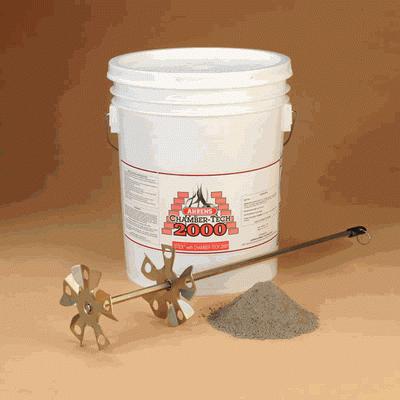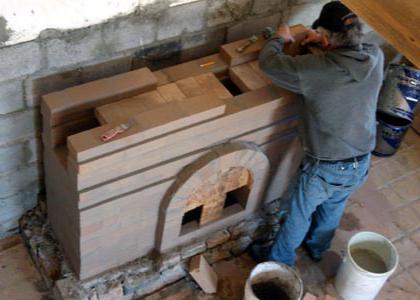From time immemorial, a good stove was considered the foundation of a solid house. It was not only a source of heat. They cooked food on it and even rested. At all times, masonry masters enjoyed great respect among the people. It was on their skill that the warmth and comfort in the house depended on cold winter days. In the process of laying the furnace there are no irrelevant details or trifles. Everything is important here. Particular attention is required for the masonry mortar. The proportions of it must be observed exactly. It is important and to choose the right components. Next, consider what constitutes a mixture for laying stoves.
General information
The composition of the masonry mortar may include various components. The final result will depend on the quality of the batch. In particular, the mixture for laying furnaces provides strength, heat resistance and tightness. A deficiency or, conversely, an increased content of any component can lead to a violation of the integrity, cracking of the structure, leakage of carbon monoxide. For the construction, ceramic bricks and a clay mixture for laying stoves are used. It is considered the best material for fixing elements. However, it is not always possible to use clay.
Material characteristic
What can be a solution for laying a furnace? The proportions of the binders determine the purpose of the material. So, it can be used directly to connect and fix structural elements or serve for decoration. A mixture for laying stoves may include not one, but two binders. In addition to clay, for example, cement is used. The filler will give rigidity to the solidified solution. A small excess of this component will not cause much damage to the quality of the structure. But even a slight excess of the proportion of the binder component will significantly reduce the strength. In this case, we are talking about clay. Therefore, it is believed that the less it is in solution, the higher will be its quality. But completely replace the clay with lime or cement is not worth it.

The consistency of the mixture for the laying of furnaces should be viscous and sufficiently ductile. But at the same time, it should not be liquid or crumble. Thick seams are not allowed on the furnace body. Their optimal size is 1-3 mm. Sand grain should not be more than 1 mm. When using a larger fraction, the amount of sand will change. Its exact proportions will depend on the quality of the clay. So, “skinny” requires a decrease in volume, and fatty is diluted in the ratio of 1 part clay and 2 parts sand. For high-quality clay and fine-grained filler, the proportion is as follows - 1: 1.
Additives
At his discretion, the master can include cement and salt in the composition of the solution . In accordance with the standard, their mixing is not assumed. But if you decide to make a complex solution, then you need to observe the following proportions: for 10 kilograms of clay you need 150 g of salt, 1 kg of cement grade M400. You will also need two buckets of sand and clay. This amount is enough for laying a hundred bricks.
Kneading and quality control
First, clay is poured into the trough. It should be filled with water in a small volume. Clay is left for a period of six hours to two days, so that it gets wet. During this time, it is mixed. For example, you can wear rubber shoes and trample clay. Water should be taken 1/4 of the available volume of raw materials. Next, sifted sand is added. The whole mixture is mixed with a shovel. You can check the consistency by the behavior of the mass. If the solution slides slowly from the shovel, mixing can be completed. To determine the ductility, a small flagellum 20 and a length of 1.5 cm should be blinded. It should be connected around a five-centimeter wooden blank. The flagellum should be stretched evenly. If it is torn, then the ends should be sharp. If there are no cracks in the bend, then the solution is too greasy. Accordingly, in the presence of numerous gaps, the mass is lean. In the second case, clay should be added, and in the first - sand. As a result, it is necessary to obtain several small cracks on the bend.

Material classification
It is not recommended to use a clay mixture in the part of the chimney that rises above the roof. This is due to the fact that due to the accumulation of condensate, cracks appear on the clay and it is destroyed. To prevent such situations, the mixture for laying stoves is prepared using lime dough. The same option is suitable for the construction of the foundation of the structure. For the solution, 1 part of the lime test and 3 parts of sand are used. To obtain the first component, it is necessary to mix 1 part of lime (quicklime) and 3 parts of water. By consistency, the main component is similar to softened fatty clay. The density of high-quality lime dough is 1400 kg / cu. m. You can also get ready-made mixtures for laying furnaces. The extinguishing of lime in the factory is carried out in special rooms using designated machines. It is not recommended to make the dough yourself. This is because lime can cause burns to the airways and skin. The fat content of the dough affects the amount of sand added. If it is increased, then 5 parts of the aggregate will be required. In this case, the consistency of the solution will be normal. Before mixing the components, the dough must be wiped through a sieve, the cells of which should be 1 x 1 cm. By adding water, the required consistency of the solution is achieved in the end.

Cement use
This component will increase the strength of the solution. The resulting mass with two binders and aggregate has a high resistance to moisture. High-quality refractory mixtures for laying furnaces, chimneys and foundations are obtained by mixing the components in the following ratio:
- 1 part of cement;
- 2 parts lime test;
- 8-10 parts of sand.
First of all, you need to mix the first and last components. Along with this, in another container, the dough is diluted with water to a viscous state. After that, dry components are added to it. The whole mass is mixed. To obtain the required viscosity, water is added in small volumes.
Heat-resistant mixture for masonry furnaces
To give greater strength, concrete is also added to the material. By its operational properties, such a solution will not be inferior to lime. Hardening of the concrete mass begins after 45 minutes. Before mixing the components, they are passed through a sieve. Then sand is poured into the prepared container, and cement is placed on top of it. This mass is mixed until a homogeneous composition. Then water is added. When mixing, it is necessary to achieve a viscous consistency. The solution should not be too thin or thick. For the construction of a monolithic furnace, components are used in the following ratio:
- 1 part Portland cement (M400);
- sand - 2 parts;
- brick rubble - 2 parts;
- fireclay sand - 0.3 parts.